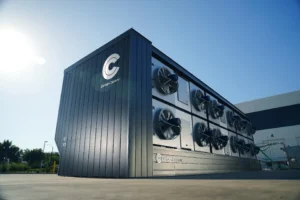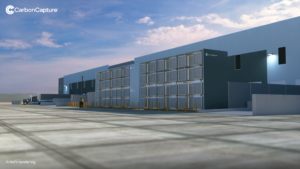EDS: An earlier version of this story included several errors, which occurred in grafs 10, 11, 30 and 31 of the original and in a photo caption. The story and caption below have been corrected, but clients who used previous versions are asked to run the correction found here.
- Slug: Carbon Capture. 900 words.
- Photos available (thumbnails, captions available below).
By Kelechukwu Iruoma
Cronkite News
WASHINGTON – As climate change continues to wreak havoc, companies in Arizona are developing technologies intended to pull greenhouse gas from the air.
Arizona’s unusually intense summer heat – with triple-digit temperatures continuing into October – plus frequent wildfires and decreased flow in the Colorado River are all linked to greenhouse gas buildup, scientists say.
CarbonCapture Inc., a climate technology company based in Los Angeles, is building an 83,000-square-foot manufacturing facility in Mesa. The facility will develop direct air capture (DAC) modules that remove CO2 from the atmosphere by drawing air through special filters called sorbents.
“This is the right time to remove carbon dioxide from the atmosphere,” said David Apps, vice president of manufacturing at CarbonCapture Inc. “It’s too late, if you want me to be honest. We’ve recognized that there’s been a problem over the last 50 years.”
A report from the Global Carbon Atlas ranks the U.S. behind only China among countries that emit the most greenhouse gas. Data released in April by the Environmental Protection Agency showed emissions in the U.S. equivalent to 6,343 million metric tons of carbon dioxide in 2022.
Emissions in Maricopa County alone amounted to 46.8 million metric tons in 2020, according to data from the city of Phoenix.
“It will be 111 degrees Fahrenheit today,” Apps said during an early October heat wave. “The urgency becomes more and more important for us.”
He said once the DAC module removes CO2 from the atmosphere, the carbon is stored deep underground or used to make products such as cement, plastics and low-carbon fuels.
The equipment will have the capacity to remove about 500 tons of carbon dioxide per year, Apps said. “When we reach total capacity, we can remove about two megatons, so 2 million tons of carbon dioxide annually based on all the modules we produce in a year.”
Arizona Gov. Katie Hobbs expressed support for the Mesa facility.
“The facility represents a significant milestone for Arizona, advancing our clean energy economy and creating skilled jobs to support Arizona’s rapidly growing manufacturing industry,” she said in a statement.
The U.S. government is concerned about the amount of greenhouse gas emitted globally and is taking steps to reduce carbon dioxide emissions.
In 2022, President Joe Biden signed the Inflation Reduction Act and created the Greenhouse Gas Reduction Fund, disbursing $27 billion in investment grants to counties, cities and businesses to mobilize financing and private capital to address the climate crisis.
The Department of Energy’s Office of Energy Efficiency & Renewable Energy said it aims to cut U.S. greenhouse gas emissions to half of 2005 levels by 2030.
The DOE’s goals include 100% carbon pollution-free electricity by 2035 and net-zero emissions by 2050.
Meeting these goals would require accelerating development and deployment of multiple technologies, DOE says, including a shift to renewable energy sources and nuclear power, along with carbon management and energy efficiency.
DOE said direct air capture technologies have been demonstrated to remove CO2 from the atmosphere, and it’s deploying $12 billion in new carbon management funding over five years, mainly for direct air and CO2 capture, transport and storage.
“Funding is now focused on helping to further derisk and reduce the cost of direct air capture technologies to make larger-scale deployment commercially feasible,” a DOE spokesperson said.
Block-Lite, a family-owned masonry company in Flagstaff, makes concrete using carbon removed from the air during production.
The process uses DAC modules to create a direct supply of carbon dioxide. The carbon is used to make cement that is then combined with water and aggregates.
The mixture is pressed into molds and placed inside a temperature-controlled chamber, driving a chemical reaction that forms solid concrete and traps carbon in the blocks.
The company plans to build a plant in Flagstaff to produce 30,000 metric tons of concrete and remove 500 tons of carbon dioxide from the atmosphere annually. The company hopes to reduce emissions from concrete-making by over 70%.
Block-Lite did not respond to requests for an interview.
Such companies can also profit by selling carbon credits to others that generate greenhouse gas.
The idea behind such credits is to create financial incentives to spur innovation and accelerate technological advances.
“Carbon credit is critically important to the goal to reduce carbon dioxide,” said Klaus Lackner, an Arizona State University engineering professor and founding director of the ASU Center for Negative Carbon Emissions, which is designing technologies that can capture CO2 from air outdoors. “But it needs to be done right, and we haven’t done it right yet.”
Lackner is leading an ASU team with Carbon Collect, a company building mechanical “trees” to remove carbon dioxide. The tree was installed in Tempe and completed the first phase of collecting air from the atmosphere.
“The idea of the mechanical tree is to be like a tree. … It collects CO2 passively from the air,” he said.
Lackner said the plan is to have many mechanical trees forming a “forest.” “Just like we have billions of cars, we could also have large numbers of these trees, and they each collect CO2 and reduce carbon dioxide emissions,” he said.
But it’s not enough to extract CO2 from the air, he said. The carbon must also be buried or otherwise sequestered to ensure it stays out of the atmosphere, no longer contributing to the greenhouse effect.
“And that needs to be certified,” Lackner said, noting the EPA needs to regulate direct air capture.
For more stories from Cronkite News, visit cronkitenews.azpbs.org.

